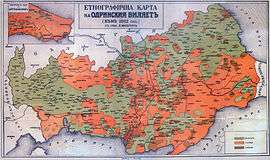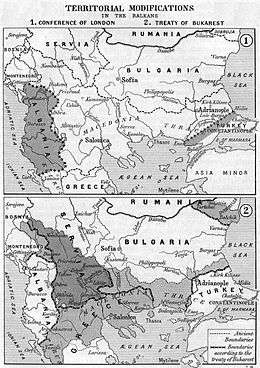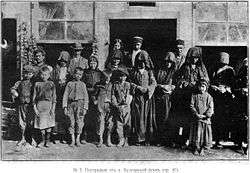Destruction of the Thracian Bulgarians in 1913


"The Destruction of Thracian Bulgarians in 1913" (Bulgarian: "Разорението на тракийските българи през 1913 г.", Razorenieto na trakiiskite balgari prez 1913 g., also translated as "The Devastation"[1] or "The Ruin of the Thracian Bulgarians in 1913"[2]) is a book, published by Bulgarian academic Lyubomir Miletich in 1918, which describes the mass extermination and ethnic cleansing, caused to the Bulgarian population in Eastern Thrace and Eastern Rhodope Mountains (now mainly in Edirne Province, Kırklareli Province and Tekirdağ Province in Turkey and in Evros Prefecture in Greece) during the Second Balkan War and in a short period after it.
Content
Whеn the military actions between Serbia, Greece, Montenegro and Romania against Bulgaria were in full progress, the Ottoman Empire took advantage of the situation to recover some of its former possessions in Thrace including Adrianople. In the beginning of July 1913 its forces crossed the Bulgarian border on the line Midiya-Enos, settled by the Treaty of London in May 1913. Because the Bulgarian troops had all been allocated to the front with Serbia and Greece, the Ottoman armies suffered no combat casualties and moved northwards and westwards without battles. Thus reoccupied territories were given back to the Ottoman Empire by the Treaty of Constantinople, signed on September 16. Despite that, the mass extermination and etnic cleansing continued in the areas controlled by the Ottomans even after this date. Shortly after the end of the hostilities the author interviewed hundreds of refugees from these regions, travelled himself in the places where these tragic events happened and systematically depicted in detail the atrocities, made from the Young Turks' regular army, Ottoman paramilitary forces and partly from local Greeks. As a result of this violent process approximately 200,000 Bulgarians were killed or forced to leave their homes and properties forever, seeking salvation in territories, controlled by Bulgarian army and paramilitary formation IMORO. The entire community of the Thracian Bulgarians was wiped out. Their inheritors in contemporary Bulgaria are about 800,000 people.
Population estimates
Alongside the 1911 official Ottoman figures, Lyubomir Miletich made the following estimates of the ethnic composition, using linguistic criteria rather than religious affiliation:
| Population estimates of Edirne Vilayet | |||||||
| Group | Ottoman 1893[3] | Ottoman 1911[4] | Miletich estimate[5] | ||||
|---|---|---|---|---|---|---|---|
| Muslims | 434,366 | 795,706 | |||||
| Muslim Turks | NA | ||||||
| Muslim Bulgarians (Pomaks) | 95,502 | ||||||
| Greeks (EOC members) | 267,220 | 395,872 | |||||
| (ethnic) Greeks | 200,000-250,000 | ||||||
| Bulgarians (BOC members) | 102,245 | 171,055 | |||||
| Orthodox Bulgarians | 203,224 | ||||||
| Armenians | 16,642 | 33,650 | |||||
| Catholics | 1,024 | 12,783 | |||||
| Other | 827 | 44,552 | |||||
| Total | 836,041 | 1,426,632 | |||||
The Ottoman authorities divided the population by religion, so all Patriarchists were counted as Greeks and the Pomaks as Muslims. The other two sources divided the population by language, so for example 24,970 Bulgarian patriarchists and 1700 Uniates were added by Miletich to the total figure for Orthodox Bulgarians.[5]
Illustrations
Footnotes
- ↑ Magdalena Elchinova (2016). Memory, Heritage and Ethnicity: Constructing Identity among the Istanbul-based Orthodox Bulgarians. Ethnologia Europaea. 46. p. 113.
- ↑ Valentina Ganeva-Raycheva (2012). Migration, Territories, Heritage: Discourses and Practices in Constructing the Bulgarian-Turkish Border. Migration, Memory, Heritage: Socio-cultural Approaches to the Bulgarian-Turkish Border. IEFSEM-BAS. p. 62.
- ↑ Kemal H. Karpat. Ottoman Population Records and the Census of 1881/82-1893 Int. J. Middle East Stud. 9 (1978), 237-274, p. 37
- ↑ Teaching Modern Southeast European History. Alternative Educational Materials, p. 26
- 1 2 The Destruction of Thracian Bulgarians in 1913, Lybomir Miletich, 1918, pp. 291 and 301
External links
- On-line publication of the phototype reprint of the first edition of this book in Bulgarian here (in Bulgarian "Разорението на тракийските българи през 1913 година", Българска академия на науките, София, Държавна печатница, 1918 г.; II фототипно издание, Културно-просветен клуб "Тракия" - София, 1989 г., София; in English: "The Destruction of Thracian Bulgarians in 1913", Bulgarian Academy of Sciences, Sofia, State printing house, 1918; II phototype edition, Cultural and educational club "Thrace" - Sofia, 1989, Sofia).



